MORE GREAT SIGHTS TO DISCOVER IN THE DORDOGNE

Recently we’ve been looking at a number of beautiful places to visit in the Dordogne—a region blessed with a wealth of attractions. There are many beautiful villages—a number of which are members of Les Plus Beaux Villages de France organisation—enough to keep a visitor occupied for weeks. The region has some lovely towns and stunning châteaux and romantic ruins to explore, fascinating cave complexes decorated with prehistoric drawings, ancient Roman sites, numerous World Heritage Sites and some of the most beautiful scenery in the country. As if all this were not enough to enchant the visitor, the Dordogne also has some of the best food in the country.
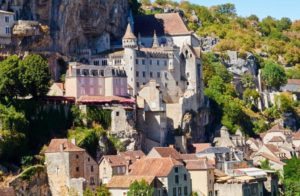
There are so many fascinating towns to discover in the Dordogne, and last time we looked at Sarlat, one of the gems of the region. As there was so much to discuss about Sarlat, there was no space to mention another “must see” in the area, namely the town of Rocamadour. Lying about 50kms to the south-west, or an hour’s drive away, it too could be added to a stay in Sarlat.
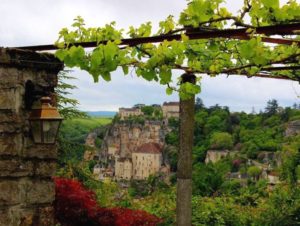
Although Rocamadour is in the departement of the Lot, when it comes to planning an itinerary of the region, it tends to be thought of as simply in the Dordogne—in fact, it’s sometimes referred to as being “at the gates of the Dordogne valley”. Its setting, in a gorge above a tributary of the River Dordogne, is one of the most spectacular sites in France and understandably, attracts hordes of visitors every year. The first sight of it brings gasps of awe as you gaze up at what is, in reality, a tiny village, whose successive levels cling high above the Alouz canyon.
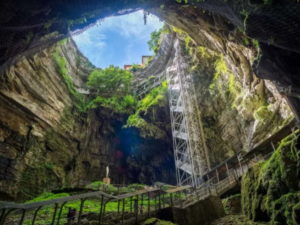
The many caves above the village were dwellings in the Paleolithic era, as shown in drawings in two of the caves, namely the Grotte des Merveilles and the Grotte de Linars. The vestiges are now in the museum at Cabrerets and the Hotel de Ville in Rocamadour. During the Iron Age, the settlement was inhabited by people thought to have been Germanic, and remains of iron weapons have been found downstream nearby, as well as tangible links to local tribes’ violent opposition to the Roman invaders during the Gallic wars.
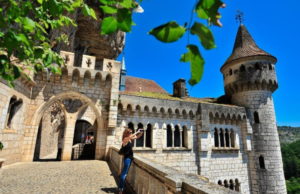
The three levels of the village that we see today date from the Middle Ages, reflecting the three orders of society of those times: the knights above, linked to religious clerics in the middle, and the lay workers down near the river. Rare documents mention that in 1105 a small chapel was built in a shelter of the cliff, just within the territories and influence of two Benedictine abbeys, Saint-Martin at Tulle and Saint-Pierre at Marcilhac-sur-Célé. In 1112, the Abbot of Tulle settled in Rocamadour, and people started making donations to the chapel sanctuary.

In 1148 a first miracle was announced, attributed to the Virgin Mary, which attracted crowds to visit the statue of the Black Madonna, carved from walnut wood, in the sanctuary, and donations from pilgrims financed the religious buildings at the end of the 12th century.
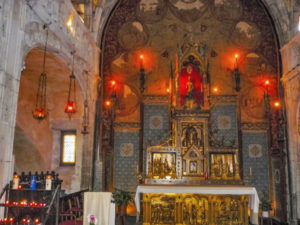
Fame of the miracles spread across Europe as evidenced by the 12th century book Livre des Miracles, written by a local monk, and in 1159 Henry II of England, husband of Eleanor of Aquitaine, came to Rocamadour to thank the Virgin for her healing powers. Now called the Chapelle Notre-Dame de Rocamadour and the Vierge Noire, it will likely be the highlight for many visitors. Rocamadour is still an important pilgrimage site en route to Santiago di Compostela.
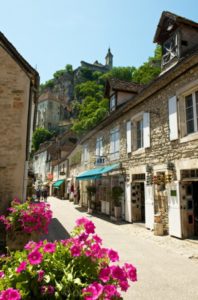
The town has four beautiful arched stone gates, with Porte du Figuier being the main gate you now enter before following the rue de la Couronnerie, Rocamadour’s one and only street. The town below the monastic buildings has many beautiful golden stone houses with lauzé roofs—a lava stone that was often used for roofing in this part of the country.

There are 233 steps that make up the Great Staircase that separates the lower town from the religious structures that are set half-way up the cliff.
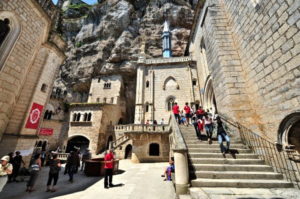
The Sanctuary itself is made up of 7 chapels built around a central courtyard. Hanging over the Chapelle Notre Dame and its Vierge Noire statue is a 9th century iron bell that is said to ring on its own when somewhere in the world the Virgin performs a miracle. There are many recorded miracles linked to sailors in peril at sea, hence the boats hanging from the chapel’s ceiling.
 Rocamadour’s stunning château was built to defend the Sanctuary in the 14th century and sits proudly at the top of the village, in what must have been an extraordinary structural balancing act. Only the ramparts are open to visitors, but the views over the Alzou Valley are simply breathtaking. Remember to keep an eye out for the birds flying to and from the ‘Rocher des Aigles’ falconry display centre nearby.
Rocamadour’s stunning château was built to defend the Sanctuary in the 14th century and sits proudly at the top of the village, in what must have been an extraordinary structural balancing act. Only the ramparts are open to visitors, but the views over the Alzou Valley are simply breathtaking. Remember to keep an eye out for the birds flying to and from the ‘Rocher des Aigles’ falconry display centre nearby.

For those that still have sufficient energy and who are looking for a view of the village as a whole, take the shady path towards L’Hospitalet. Inhabited as early as the Upper Paleolithic era, this hamlet offers a picture-postcard view of the golden stone village cascading down into the canyon.
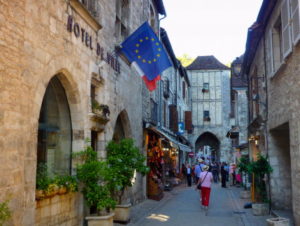
The town has a number of inviting restaurants, quirky boutiques and the usual small shops selling a range of the expected tourist-oriented merchandise.
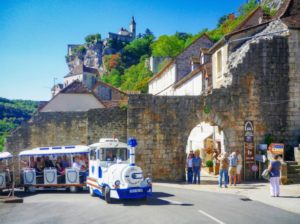
The town is entirely car-free, so vehicles must be left at the bottom. Visitors have the option of either walking up to the village entrance or taking the little tourist “train” that trundles back and forth during the day—which we suggest is a wise decision in order to save your energy, given the topography of the town and its sights. Other things to bear in mind is that the village is still an active place of worship, so visitors are asked to dress accordingly. Also, with about one million visitors flocking to Rocamadour every year, it’s worth trying to plan your visit for as early in the morning as you can manage, before it becomes too busy later in the day.
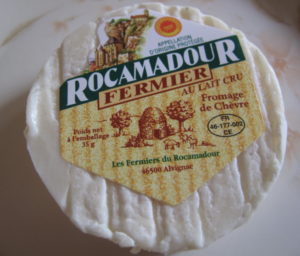
Rocamadour is also famous for its deliciously rich but delicate goats’ cheese. You can discover how it’s made at the farm of Borie d’Imbert, situated at the exit from Rocamadour.

For an absolutely unique perspective of Rocamadour, think about taking a hot-air balloon ride over the site. The appropriately named Montgolfières du Périgord is one company to check out, also Viator—a Google search will locate their respective websites. Hot-air ballooning is now so popular in this region that there is a Rocamadour Hot Air Balloon Festival, called the ‘Montgolfiades’ held every year on the last weekend in September, which would be a lot of fun to see.
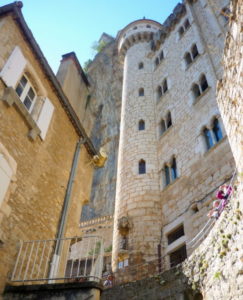
As a place of legend and with so much history, it’s no wonder that Rocamadour is a UNESCO World Heritage Site.
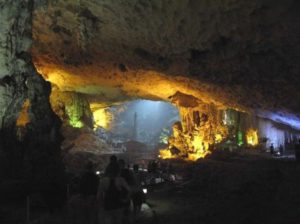
As mentioned, above Rocamadour is the village of L’Hospitalet, and just 100m. from the tourist office in the Hotel de Ville, is the Grotte des Merveilles. Discovered by a local landowner on 16 October 1920, the Paleolithic cave has been classified as a Monument Historique since May 1925. The cave is a long oval space of 45m x 25m wide and 3m high, which contains many spectacular natural stalactites formations and “Uygur” (water pool terraces, or small waterfalls). In the recess of one of the walls are ancient representations of hands, horses, a deer and a cat, engraved or painted red or black onto the rock. Scholars have dated these drawings to around 20,000 years old. Guided tours are obligatory, and are available in English on request.
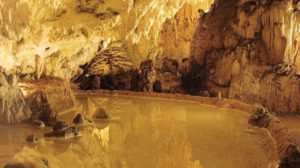
The Grotte is open daily, except Fridays, from April to early July and from Sept. to early November. Cost is around €8. Be aware that the temperature in the Grotte is around 13 deg., so take something warm to wear, and no photography is allowed inside, due to the fragility of the wall paintings, but despite this slight obstacle, it’s a very impressive sight.
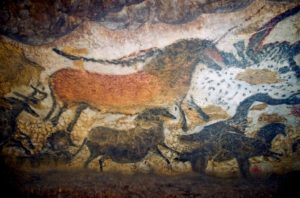
Speaking of caves, one of the most famous sights in the Dordogne, indeed the whole country, is the cave complex at Lascaux that lie about 26kms north of Sarlat. It is the highest concentration of such caves in Europe with over 600 wall paintings primarily representing large animals, human figures, abstract signs, and fauna that correspond with the fossil record of the Upper Paleolithic in the area that date from around 17,000-20,000 years. The cave galleries suggest a certain continuity, and have been given names such as the Hall of the Bulls, the Passageway, the Shaft, the Nave, the Apse, and the Chamber of Felines.
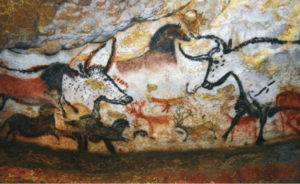
The entrance to the cave was discovered in September 1940 by a local boy when his dog, Robot, fell in a hole. When the boy returned with some mates to rescue Robot, they thought they had found a legendary secret passage to the nearby Lascaux Manor. Instead, the boys discovered that the cave walls were covered with depictions of animals.
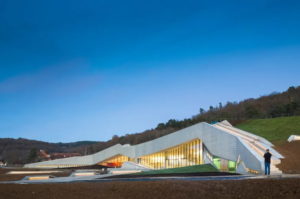
The complex was opened to the public on 14 July 1948, and has been designated as a UNESCO World Heritage Site since 1979. The original caves have been closed to the public since 1963 as their condition was deteriorating with unacceptably high levels of carbon dioxide, heat, humidity and other contaminants which had visibly damaged the paintings. Another problem was that as the quality of the air declined, fungi and lichen increasingly infested the walls. These conservation problems made the creation of replicas even more important, and now there are a number of very high quality replicas, that unless you’re an expert in such matters, are indiscernible from the originals. The original caves are now hermetically sealed, where none but a few specialist scientists can enter.
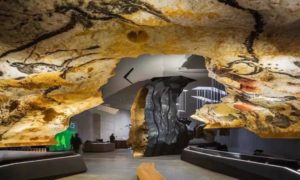
Lascaux II, an exact copy of the Great Hall of the Bulls and the Painted Gallery, was displayed at the grand Palais in Paris before being displayed from 1983 near the original at Lascaux. The reproductions were duplicated using the same type of materials such as iron oxide, charcoal and ochre. Lascaux III is a series of five exact reproductions of the Nave and the Shaft, that, since 2012, have travelled around the world allowing knowledge of Lascaux to be shared, far from the original.
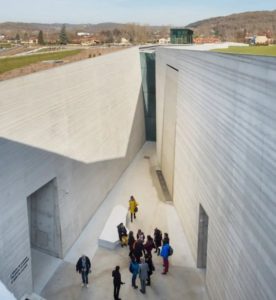
Lascaux IV is the newest reproduction of the painted areas that forms part of the International Centre for Parietal Art (Centre International de l’Art Parietal). This highly accurate replica also integrates digital technology into the display, and is presented in a new museum building inside the hill overlooking nearby Montignac. The Lascaux complex is open all year except January – mid February, and is closed on Mondays in the low season. It’s best to buy tickets in advance to avoid a long queue.
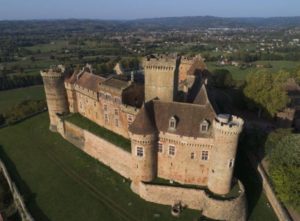
To round out this further exploration of the many attractions of the region, let’s head to the Château de Castelnau-Bretenoux in the département of the Lot. Along with Château de Beynac, which we looked at in the blog Les Plus Beaux Villages in the Dordogne-Perigord a few weeks ago, one of the other exceptional châteaux of the region is Château de Castelnau-Bretenoux. It’s about one hour 20mins. or 68 kms east of Sarlat, and 28kms N.E. of Rocamadour.
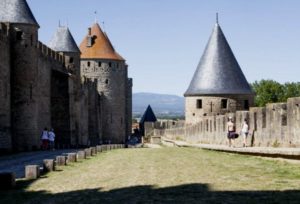
Construction began around 1100, and enlarged several times between the 12th and 15th centuries, when it was necessary to adapt the fortifications to resist artillery attacks and long sieges. It was taken by Henry II of England in 1159, and returned to the powerful barons of Castelnau, at the end of the Hundred Years’ War. More peaceful times during the 17th century saw improvements such as large windows, richly decorated salons, and a balcony of honour.
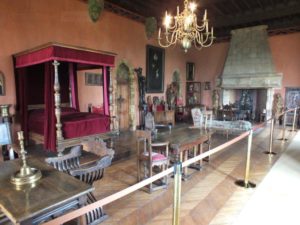
The Château fell into disrepair after the death of the last Castelnau in 1715, and a devastating fire in 1851, and was bought by Jean Moulierat, a tenor with the Paris Opera Comique in 1895. He was also an important collector of furniture, objects d’art and sacred artworks, and undertook extensive restoration and refurbishment of the château , using his vast collections. On his death in 1932, he gifted the château to the state, with one very important stipulation, that nothing be rearranged or removed—even the photo frames are exactly where he left them. There are about seven rooms in the château open to visitors that are fully restored and furnished in the medieval style.
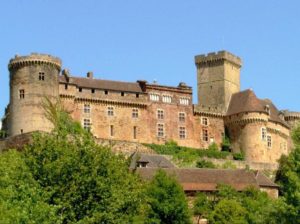
The château is located on the top of a hill, where several valleys intersect, and where the river Dordogne flows through one of them. Due to its prominent position, the château dominates the skyline in every direction, and is visible from quite a distance. It’s easily recognisable by its walls of red stone, which seem to gleam in the sunlight like a beacon.
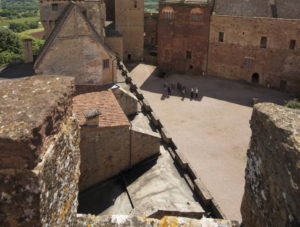
One of the finest examples of fortified medieval architecture in the Dordogne, the château is very imposing, with three enclosing walls, wide curtain walls, 9 round towers and a gigantic medieval donjon (keep). When you explore its outer walls, you can’t help but notice the thickness of the stone that allowed this stronghold to withstand the ravages of many wars and invasions. A must-do is to walk up to the top of the keep, taking the 90 or so steps of the narrow spiral stone staircase. It’s worth every effort for the stunning 360 degree views from the top, across the Dordogne valley and beyond. An attractive small village now surrounds the château, along the slopes of the hill.
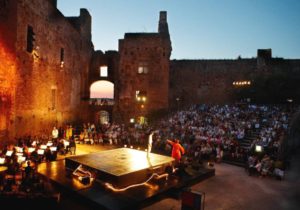
As part of the yearly Saint-Céré Classical Music Festival, you can attend operas and concerts inside the courtyard of Château de Castelnau-Bretenoux every summer.
One thing to mention here: don’t confuse this château with the Château de Castelnaud, which is near Domme and Sarlat.
The Dordogne region is richly endowed with so many attractions to enchant the visitor, and these are just a few more of them.
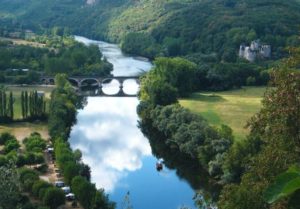


Leave a Reply